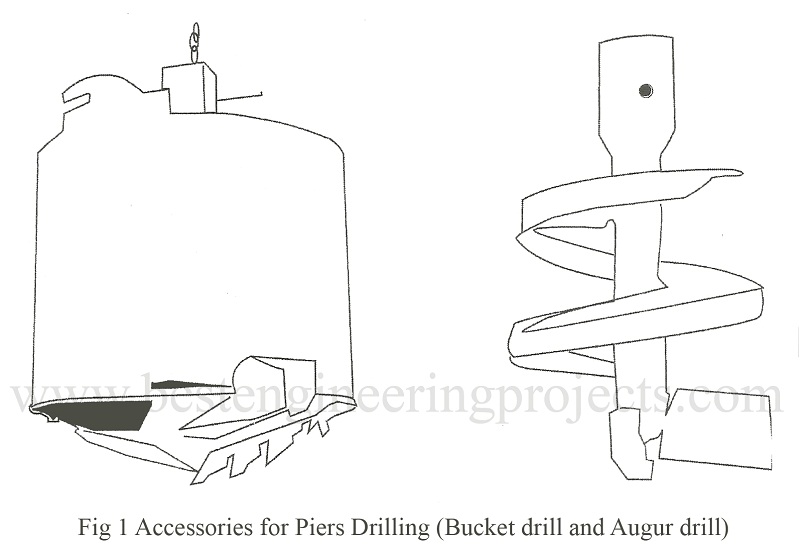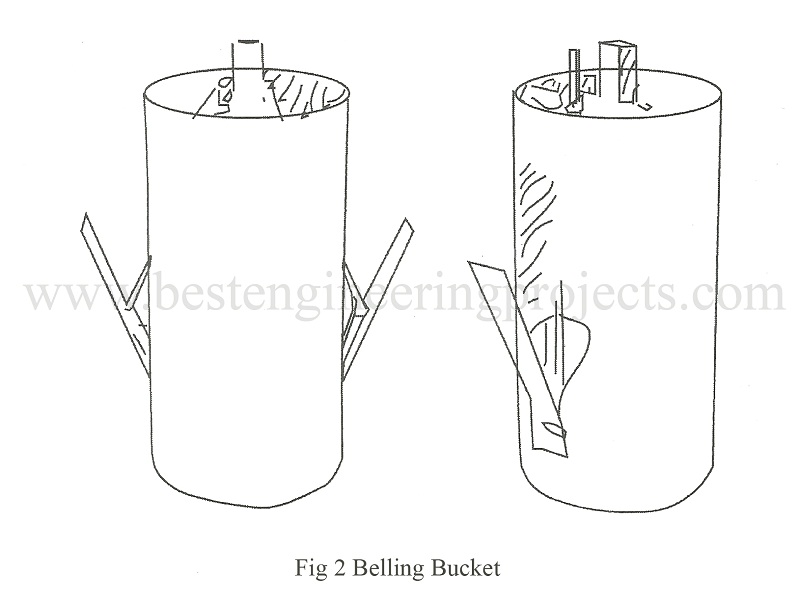What are the Construction of pears using mechanical method
Drilling – When piers are constructed by drilling, they are called drilled piers. The excavation is carried out by an auger type of drill which looks like a carpenter’s auger. The tools used are a drill bucket and a chopping bit. The drill bucket has an opening at the bottom with cutting edges or teeth. It is provided with a door to collect the cut soil. As the bucket is rotated and forced down the cutting edges save the earth and scoop in the bucket. Then the bucket is lifted above the ground and emptied out by opening bottom which hinges to the side. The chopping bit is used to break boulders or hard soil. The various tools required for construction is shown in Fig. 1 and 2 below.
Formation of the bell – When the shaft is excavated up to the required depth, the bearing stratum is examined and the belling bucket is introduced in the shaft. A reamer attached to the bucket forms the bell. The reamer gets gradually opened when the bucket is forced into the soil. When bucket is rotated, the reamer forces the soil in the bell.
Concrete Placement – Tremie pipe or dump bucket used to pour concrete. A dump bucket is a bucket with a door at bottom. During concreting segregation is the main problem. The mix is usually made stiff with a slump less than 3″. The concrete shall not hit the side of the hole so as to cause sloughing of the soil. Casing, if any, shall be retracted as the concrete is poured.
Compaction of the concrete is carried out only at the top 3 m of the pier. At depths below 3 m it is believed that the self-weight of the concrete compacts it. In the bell, concrete should not be compacted by vibration as caving-in may result. Concreting should be done in dry condition as far as practical. Underwater concreting shall be done if there is excessive seepage pressure.
Inspection of Construction – The inspection is done for:
- Accuracy of alignment and dimension
- Bearing capacity of the soil at the bottom
- Removal of loose soil from bottom
- Risk of loss of ground
- Process of Concrete placement
The caisson should not be allowed to shift by about 50 to 75 mm from its exact location. The tilt shall not exceed 1 % of the height or depth of caisson. These tolerances should be accounted for in the design.
The strength of the soil at the bottom shall be inspected by spot-checking. In uniform soil one out of 5 to 10 caissons should be checked. In erratic soil every caissons should be checked. The thumb test should be carried out to ascertain the strength of the clay soil. Alternatively a pocket penetrometer may be used.
The cleanness of the caisson bottom may be inspected by the aid of mirror to reflect the sunlight. But the most reliable procedure is to examine the condition by descending down to the bottom of the hole.
In caisson drilling there will be risk of ground loss due to excessive dewatering, which could threat in the stability of the adjacent structures. When danger of ground loss is confronted, the hole is to be excavated under water. Alternatively, drilling fluid is used to prevent cave-in and bottom blow out.

